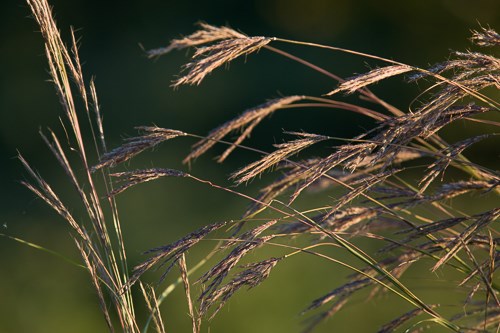
NPS/Gordon Dietzman IntroductionBig bluestem is often the dominant grass of the tallgrass prairie, an ecosystem dominated by grasses. Growing more than eight feet tall in good years, large stands of big bluestem, along with other grasses, fed enormous populations of prairie animals ranging from grasshoppers to bison. For grazers, big bluestem provides a moderate amount of protein and high palatability. It can grow in a wide range of soils types and chemistry, is drought resistant, prefers the heat and light of full sun, and is adapted to a plant community often swept by natural or human-set fires. Its extensive, fibrous root system effectively stabilizes soil preventing erosion. This characteristic prairie grass adds height and structure to any prairie planting. The seedheads are a purplish red in the fall and its stems and leaves turn a subdued russet in autumn. Big bluestem grows well in dry to wet environments, but it thrives in prairies of moderate moisture. As a result, even though it is found native in most U.S. states, it is most common in the Midwest, rather than the drier prairies that lie in the rainshadow of the Rocky Mountains. Big bluestem may produce seeds after the first year, under favorable circumstances, and the second year if resources are limiting. Fascinating Facts
Find ItColdwater Spring Want to Help Us Better Understand the Park?See our iNaturalist project, "The Life of the Mississippi National River and Recreation Area" and contribute to it by downloading the iNaturalist app and uploading your sightings of this species, and others, to the project. You can also upload your sightings from your computer as well. |
Last updated: February 16, 2023
